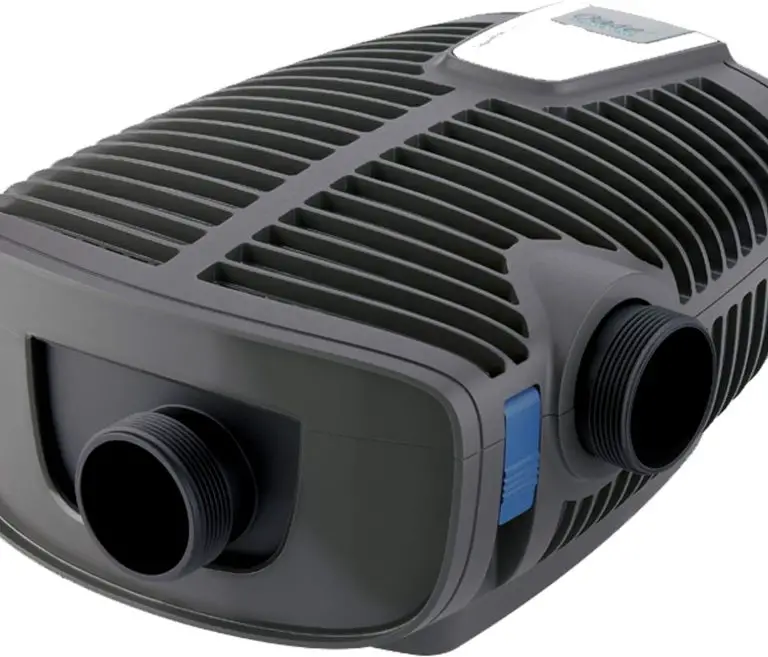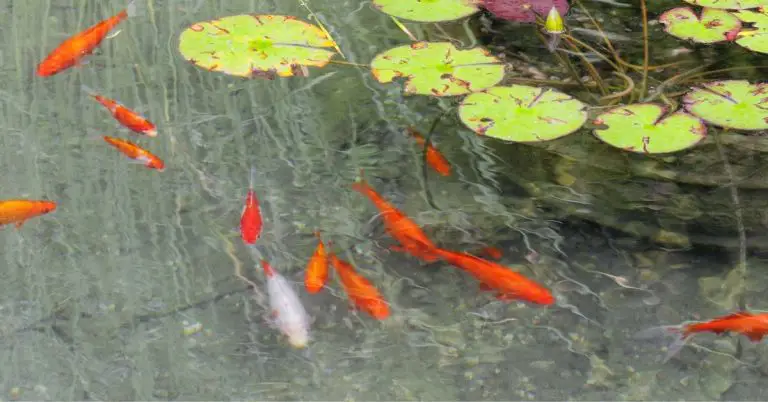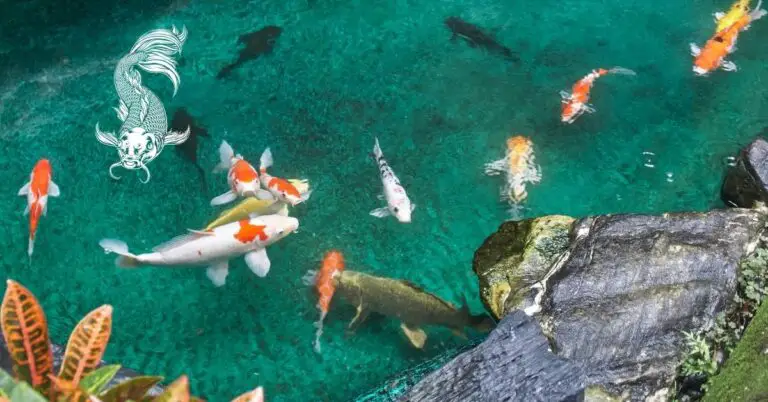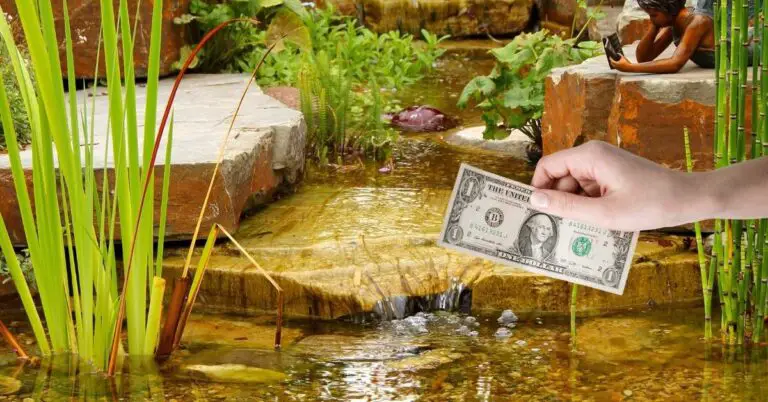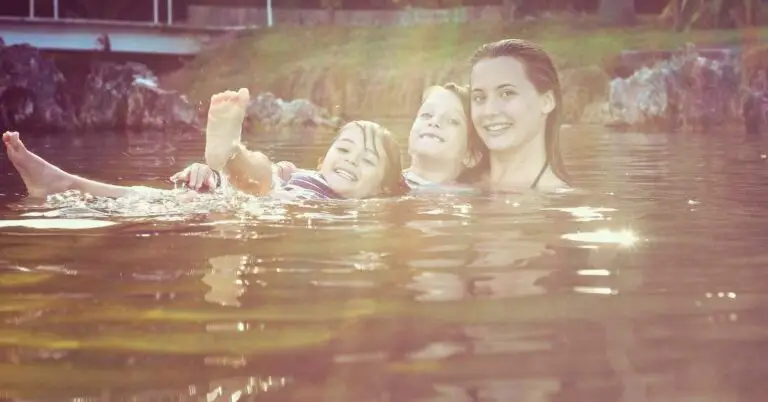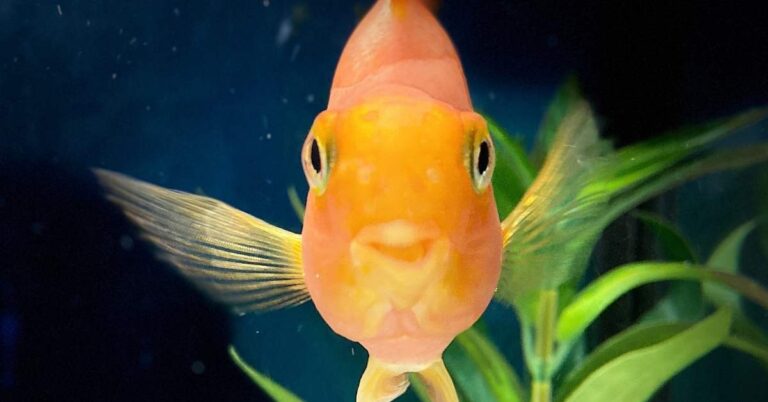How To Keep Your Pond Cool In Summer & Extreme Heat Waves
Backyard ponds, like all small bodies of water, are particularly susceptible to drastic changes in temperature. In the hot summer months, this means overheating which can have deadly consequences for your pond and all the living things within it. This has become especially important in recent years as much of the world is experiencing hotter temperatures and longer heat waves than ever before. So, what are the best ways to keep your pond cool in extreme heat conditions?
The best way to keep your pond cool is by providing it with adequate shade, increasing circulation and oxygenation of the water, and making sure the pond is deep enough to accommodate a cold bottom layer of water. Doing these things will help protect the living things within your pond, such as fish and plants, and in turn help to preserve its delicate ecosystem during these hot summer months.
Keep reading as we go over how to determine if your pond is too hot as well as ways to cool it down if it is.
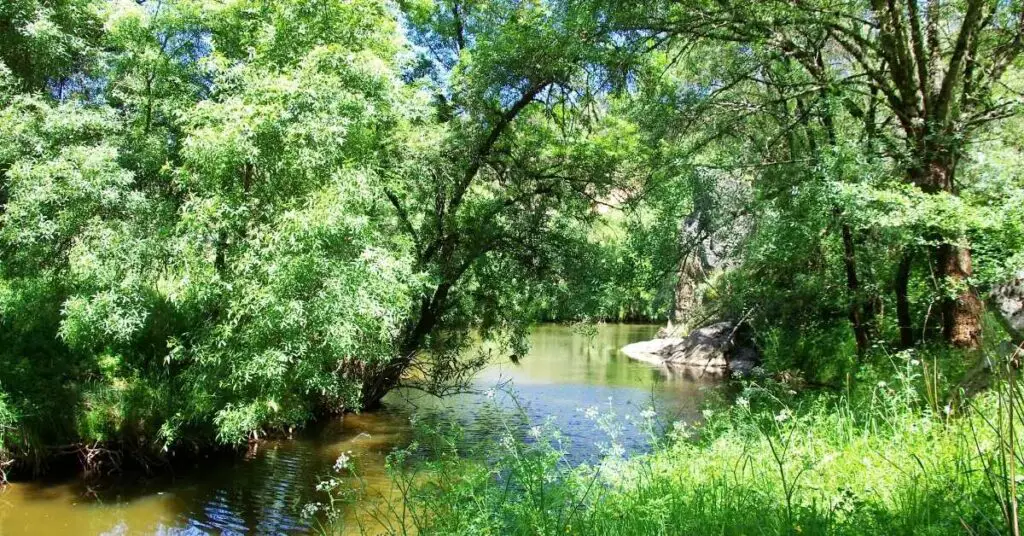
How To Tell If Your Pond Is Too Hot
The first step to keep your pond cool is to determine if it’s too hot to begin with. This can be done by monitoring the temperature of your pond at all times using a pond thermometer.
The easiest way to tell if your pond is too hot is with a simple floating pond thermometer. These thermometers float on the surface of the water and give a reading of the temperature you can easily see. However, this simplicity comes with the downside of only being able to see the temperature at the surface and not further down into the lower levels of the pond.
In many cases, this might be OK since the surface of the pond is what heats up first. You can use the floating thermometer as a kind of early warning system to let you know when you need to act fast to get the temperature of your pond to a more acceptable level. However, it’s important to know the temperature of the deeper levels of water in the pond since this level is where many kinds of fish and other aquatic life go to escape the heat on the surface when it gets hot.
The best way to know the temperature of your pond at all water depths is by using a submersible thermometer. Submersible thermometers come with a probe attached to a long wire that can read the temperature of your pond at multiple levels, including the very bottom. This is a highly accurate way to gage the temperature of your pond and determine the best course of action necessary to cool it down at higher temperatures.
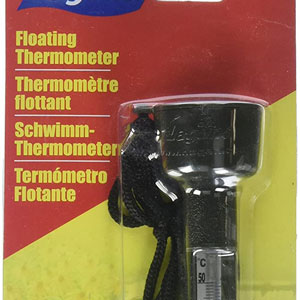
Floating Pond Thermometer
This thermometer floats in your pond and gives you a reading of the temperature at the water’s surface.
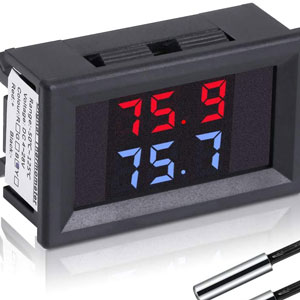
Submersible Pond Thermometer
Digital thermometer with a 3ft probe to get temperature readings from the deeper levels of your pond.
Common Fish Temperature Ranges
Different kinds of fish have different sensibilities when it comes to what’s too hot or too cold. Below is a handy list of the preferred temperature ranges of common fish.
| Common Fish | Recommended Temperature Range |
|---|---|
| Goldfish | 68F to 74F |
| Tiger Barb | 77F to 82F |
| Plectostumus | 75F to 82F |
| Cardinal Tetra | 73F to 81F |
| Rams | 84F to 86F |
| Angelfish | 78F to 84F |
| Betta | 75F to 80F |
| Zebra | 64F to 75F |
| Hatchetfish | 72F to 81F |
| Danios | 70F to 78F |
| Clown Loach | 77F to 86F |
| Guppies | 74F to 82F |
| Harlequin Rasbora | 72F to 82F |
| Minnows | 64F to 72F |
| Silver Dollar | 75F to 82F |
Why A Hot Pond Is Dangerous
A hot pond isn’t just uncomfortable for your fish, it’s actually dangerous.
Fish have very specific temperature ranges they can live within, just like humans. But unlike humans, fish can’t simply leave your pond if it gets too hot. They’re stuck inside the tiny ecosystem you’ve created for them and completely at the mercy of your intervention if something goes wrong.
In addition to violating your own fish’s heat sensibilities, hot temperatures sap them of the resources they need to live as well. Fish breathe by absorbing dissolved oxygen into their gills, but as the temperature rises the levels of available oxygen in the water goes down. This can potentially cause your fish to become sick, suffocate and eventually die.
Hot temperatures also encourage the growth of unwanted organisms in your pond such as harmful bacteria and algae. These overgrowths not only make your water murky and unpleasant looking, they also sap the water of nutrients that fish and useful bacteria need to live.
How To Prevent Your Backyard Pond From Overheating
Once you’ve determined that the temperature of your pond is dangerously high, it’s time to take action to cool it. Cooling your pond can be as easy as providing some simple shade covering during the hot season, or as involved as restructuring your pond to be deeper and having more places for your fish and plants to get respite and protection from the heat.
Keeping your pond cool, and its water fresh and clean, will help to make sure your pond stays healthy and full of life.
Shade Protects Ponds Better Than Anything Else
Shade is probably the easiest and single best method to protect your pond, and the life within it, compared to almost any other method. Shade prevents harmful heat and UV light from ever reaching your pond’s water in the first place.
An easy way to provide shade for your pond is by installing a “shade sail” over your pond. A shade sail works just like an awning or sun umbrella in that it blocks the sun and keeps whatever is underneath it substantially cooler.
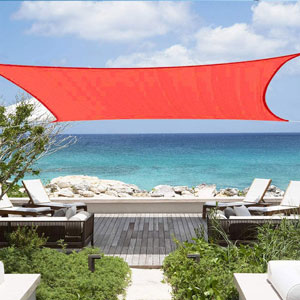
Sun Shade Sail
This sun shade sail will block sun while also allowing cool breezes to pass through, keeping your pond’s temperature low.
Another great way to provide shade for your pond naturally is with the use of plants, both inside and outside of the water. Large plants with big leaves planted near the perimeter of your pond go a long way towards cooling down your pond and bringing the temperatures back to levels at which plants and animals in the water can thrive. This is why it’s actually advisable to build ponds in the shade or to plant trees near an already built one.
Also, be sure to keep your pond clear of any leaves that fall onto the surface of the pond to avoid decay and ruining your water’s quality.
Aquatic plants are another way to naturally provide shade for your pond. These are plants that have large pads that float on the water and block the sun and its harmful rays from penetrating the surface. Some good choices for plants that block heat are ones like water lettuce and various kinds of lilies.
Aeration Keeps Oxygen Levels High
Aeration refers to the process of incorporating air into your pond’s water which in turn increases its levels of oxygen that’s vital to the life of anything living within it. This is also called “gas exchange” because it brings in helpful gasses like oxygen while removing harmful gasses like ammonia.
The reason aeration is so important in protecting your pond from extreme heat is because there is an inverse relationship between temperature and the amount of dissolved oxygen available in your pond’s water. This means as the temperature rises, oxygen levels fall and this can be deadly for the fish and animals that depend on it (source).
In addition to gas exchange, aeration can also help to moderate the temperature of the water by keeping things moving and bringing in fresh air from the outside.
The best way to encourage aeration in your pond is with the use of waterfalls and fountains. These kinds of water features collect oxygen molecules from the air and deposits them back into the water as it forcefully splashes back down.
Circulation Is Key To Keeping Pond Water Cool
Similar to aeration, water circulation is vital to keeping your pond’s water from becoming stagnant as well as too hot during the summer months.
The easiest way to keep your water circulating is by adding a pump, waterfall, stream or bubbler. Circulation is incredibly important in terms of making sure oxygen and other nutrients are equally distributed in the water as well as helping to keep it cool. A pond’s water should be actively circulating at all times to avoid stagnation and stratification of its layers.
Another benefit to having a constant, 24/7 pump going in your pond is that it helps to avoid the dreaded “turnover” which can quickly kill all life within your pond. Pond turnover is especially dangerous during hot summer months. You can read more about pond turnover and how to avoid it here.
Caves Give Pond Creatures A Place To Escape The Heat
Caves are a great refuge for fish and other aquatic wildlife in your pond, especially when made of stone. These caves provide protection from the sun and a cool spot for your fish to hang out during the hottest days of the year.
You can make a pond cave yourself quite easily by placing some large stones together to create a space that’s shielded from the sun. Just make sure the stones are securely in place – you don’t want the stones collapsing in on themselves and injuring your fish.
You can also buy premade fish shelters that provide shade as well as protection from predators like birds and other animals. These won’t be as cool as a thick stone, but the shady protection from the sun should do the trick just fine and without the risk of the stones collapsing.
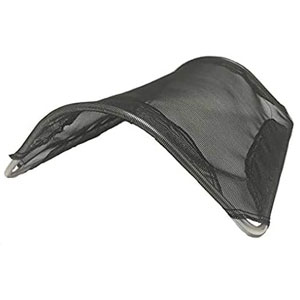
Koi/Fish Cave
A great, ready-made hiding place for your fish to find safety and shelter against the hot sun.
How To Cool Your Backyard Pond Fast
Prevention is the best medicine, as they say, so it’s always advisable to take action towards protecting your pond before it gets hot. However, sometimes you might not notice anything is wrong until it’s too late such as in the middle of an unexpected heatwave.
Here are some ways to cool your pond quickly to get you through the dog days of summer, or in the event of a severe heatwave.
Ice
Just like a cold glass of drinking water, ice can be used to cool down your pond’s water and keep it cool. At least until the ice melts. This might seem like an overly simplistic solution but it actually works quite well to get your pond to an acceptable temperature in a pinch.
You can always just take a bunch of ice cubes and throw them in your pond, but this isn’t the ideal way to go about things. For one, the ice cubes will melt faster by themselves and not provide as much cooling as they could as one large chunk. Secondly, but perhaps most importantly, your pond’s water is likely carefully balanced for pH levels and nutrients, so throwing in a bunch of frozen tap water can throw this balance off.
I recommend freezing a large batch of water in some kind of sealable container, like a bucket. This way you’re dealing with one giant ice cube (essentially) that when melted won’t mix in with the rest of your pond’s water.
You can easily drop the container into the pond and monitor the change in temperature to see how effective it is. When the container of ice eventually melts, you can easily replace it with another one. This works best if you place the bucket near the outflow of one of your pumps to help circulate the cold water throughout the pond.
Partial Water Change
Partial water changes are something that many pond owners do on a regular basis to prevent their water from becoming stale. It’s not necessary to do this all the time if you’re taking care to keep your water fresh with constant aeration and circulation, but it’s not a bad idea either.
A partial water change can be especially useful during hot summer months if you use cool water as a replacement as it can drastically lower the temperature of your pond if it’s getting too hot.
Remember that you don’t need to replace all of the water in your pond, usually less than 15-20% will do the trick. Also, be advised that if you’re using tap water you’ll need to use a dechlorinate product to take care of any chlorine and/or ammonia that might be present. Many people collect rainwater for this purpose as it doesn’t need to be treated at all.
As always, make sure to check the pH levels of your pond before and after making doing any water replacement. This will ensure that your new mixture of water is safe for your fish to survive and thrive.
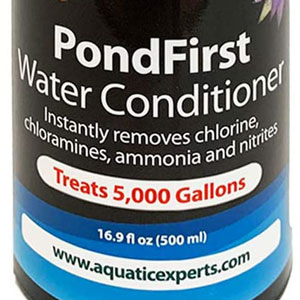
PondFirst Water Conditioner
Makes tap water instantly safe by removing chlorine, and chloramines; it also detoxifies ammonia.
Related Post: What pH Level Is Best For A Koi Pond?
Clean Pond Water Prevents Toxic Turnover
Cleaning your pond at regular intervals is always necessary, however it’s especially important to keep your pond clean during the summer months.
High heat can and lots of sun can feed unwanted bacterial growth in your pond which can trigger things like algae blooms. This can have the unwanted effect of sapping your pond’s water of all the oxygen and beneficial bacteria it needs to stay healthy.
Remember that having an ample amount of stones and pebbles in your pond really helps keep your pond clean and healthy. The surfaces of these stones provides a home and breeding ground for beneficial bacteria to grow and keep your pond’s ecosystem in balance.
Related Post: How Often Should I Clean My Backyard Pond?
A Tint Can Protect Your Pond From Sun Damage
It’s well known that many kinds of pond fish prefer a slightly opaque water that mimics the murkiness of their natural habitats. Water that isn’t completely translucent gives them comfort as they are not as easily seen by predators.
Tinted water also has the added benefit of providing shade to the creatures within, just like how a pair of sunglasses protects our eyes from sun damage.
Combined with the methods listed above, adding a slight blue tint to your water can help to bring down the temperature quickly and give some respite to your fish from the harmful impacts of sun damage and overheating.
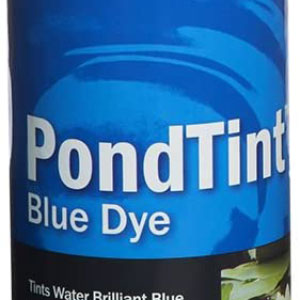
PondTint Blue Dye
This PondTint blue dye will tint your pond water blue and protect it from the harmful effects of the sun.
Don’t Overfeed Fish
It’s never a good idea to overfeed your fish, but it’s especially important to remember this during the hottest days of the year.
When excess food sits at the surface of the pond for too long without being eaten, it eventually sinks to the bottom where it begins to decay. Decayed organic matter gives off toxic gasses like ammonia while also depleting your pond of oxygen.
If left unchecked, this can lead to sudden and deadly events like pond “turnover”. Pond turnover happens when toxic, uncirculated water stratifies the layers of your pond which then mixes with the healthy layers of water above. Pond turnover circulates toxic gasses and depletes oxygen which is a death sentence for your fish and the rest of your pond’s delicate ecosystem.
Related Post: How To Tell If A Pond Has Turned Over
Deeper Ponds Stay Cooler In Hot Weather
Most backyard ponds should be at least 2 feet deep to prevent overheating from the sun as well as to give any creatures like fish enough room to live and thrive. This becomes especially important when dealing with extreme heat or heatwaves as much of the world is increasingly experiencing as of late.
If you live in a hot part of the world, or one that experiences regular extreme heatwave events per year, you should consider adding some extra depth to the pond. Extra depth prevents your pond’s water from becoming too hot and gives your fish a cool place to go during periods of extreme heat.
Lower levels of your pond receive less sunlight which is beneficial, however it also has lower levels of oxygen and potentially higher levels of toxic gasses if not cleaned properly, so you’ll want to make sure your pond isn’t too deep – say, over 6 feet. Anything under this level should be fine, however.
Related Posts:
How Often Should I Clean My Backyard Pond?
Comforting A Dying Fish – How To Help Your Pet Fish Through Their Final Days
Milky, Cloudy Koi Pond Water: 11 Causes & Solutions
How To Tell If A Pond Has Turned Over
Related Questions:
How Can I Keep My Pond Cool In The Summer?
The best way to keep your pond cool in the summer to prepare in advance by having ample shade, lot’s of dark hiding places for your fish and an adequate water depth. A great way to provide shade is to install a “shade sail” above the surface as well as placing one or more fish “caves” where they can go to keep cool and feel safe. Aquatic plants with large pads like lilies and water lettuce are great ways to beat the summer heat as well.
How Can I Cool My Pond Water?
To cool your pond water quickly, consider installing a sail shade just above the pond’s surface to block the sun’s harmful rays and drop the temperature to a more acceptable level. You might also want to use a blue water tint to filter out sunlight from penetrating the deeper levels of pond water and warming it up too quickly.
Can Water Get Too Hot For Koi?
In general, a koi pond should not go above 80F or else it can become dangerously hot for your koi fish. When water gets too hot, your koi fish will become stressed and even ill. Remember, stress is the leading cause of premature death and illness in fish so keeping your pond cool can be a matter of life and death for your koi.
Can Hot Weather Kill Pond Fish?
When the weather gets hotter, the oxygen levels in your fish pond become depleted. This not only reduces the amount of dissolved oxygen available to your fish, it also increases the levels of harmful toxic gasses like ammonia. This is why it’s so important to proactively monitor the temperature of your fish pond during the summer or other periods of extreme heat.
Should I Cover My Pond In Summer?
In general, it’s a good idea to cover your pond with ample shade during the hot summer months. This doesn’t mean sealing it over with a tarp, rather you can use something called a “shade sail” that is easily and inexpensively installed above the water’s surface. A shade sail works the same as a sun umbrella by providing shade and protecting your pond from extreme heat produced by direct sunlight.

